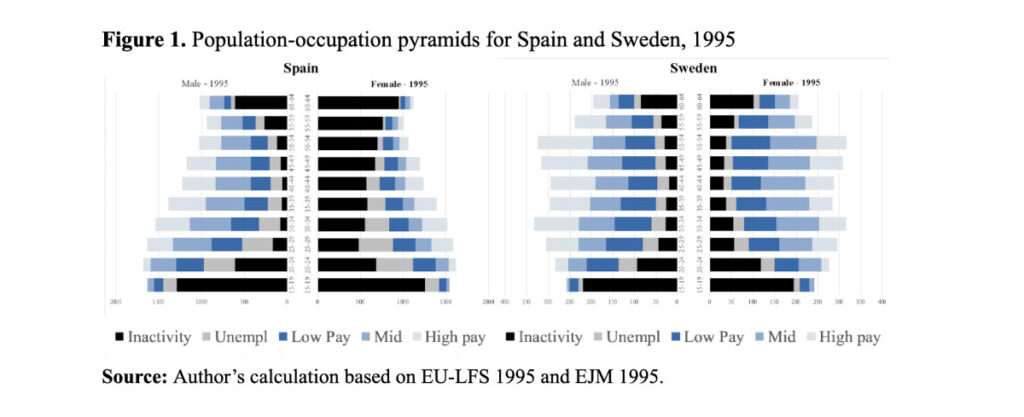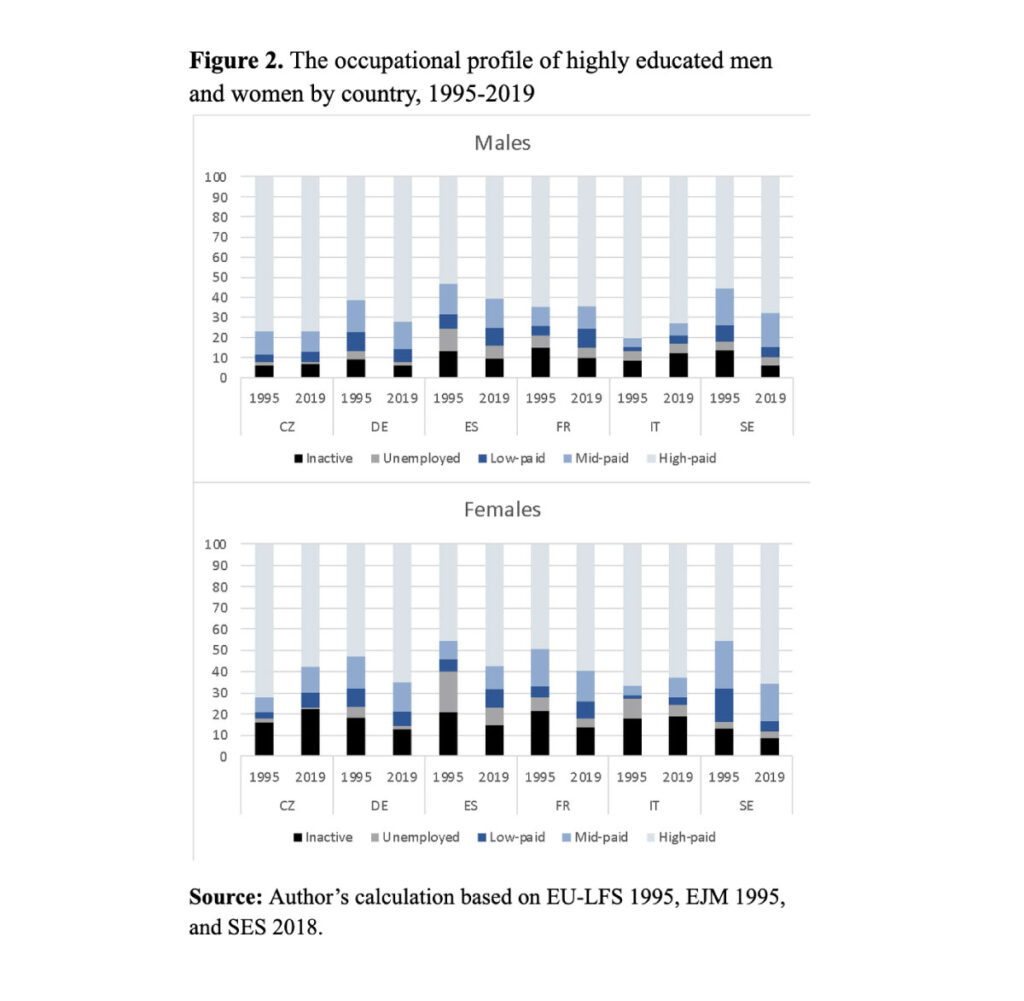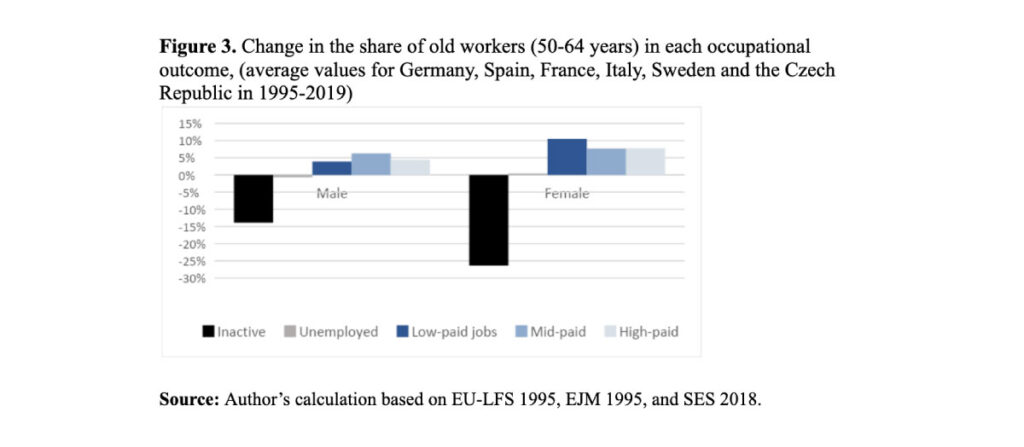Over the last decades, the working population in Europe has become older, more feminized, and more educated. However, Álvaro Mariscal‐de‐Gante, Amaia Palencia‐Esteban, Sara Grubanov‐Boskovic and Enrique Fernández‐Macías argue that female occupational improvements have been insufficient to close the gender gap, and find declining occupational returns to education for highly educated women in two countries. Conversely, European labour markets have been able to accommodate the growing number of older workers, despite some occupational downgrading.
European societies are undergoing significant demographic changes, most notably the trend towards feminization and ageing of their workforce. Intertwined with a process of educational upgrading, these shifts are reshaping the landscape of the continent’s labour market (Lutz and Skirbekk 2014).
To respond to these challenges, the European Union (EU) and its member states have implemented a series of policy initiatives aiming to promote longer working lives and reform social protection and pension systems. In 2020, the EU’s Green Paper on ageing outlined strategies for addressing these challenges, propelling the twin transitions towards a greener and more digital Europe while nurturing the ageing population’s potential (European Commission 2022).
In a recent paper on this topic (Mariscal‐de‐Gante et al 2023), we used recent occupational and demographic data for six European countries to briefly illustrate and discuss three of these major demographic challenges, namely gender disparities in the labour market, the effects of educational improvements on employment, and the ageing of the working population.
Has increased female participation widened the gender occupational gap?
Population pyramids intuitively show the major demographic changes faced by European countries over the last 25 years. In 1995, countries like Spain, Italy, or the Czech Republic still exhibited the classical pyramidal shape, reflecting a great number of young workers and smaller cohorts of old individuals. In contrast, Germany, Sweden, and France already showed a narrowing base, indicating earlier declines in fertility rates and incipient population ageing (Spain and Sweden are shown in Figure 1). Despite these differences in structural demographic shifts, a common thread ran through all these countries: inactivity, unemployment, and low-paid jobs were relatively more prevalent among women.

Between 1995 and 2019, while inactivity and unemployment tended to decline significantly, there was a widespread process of occupational upgrading, with growing employment shares in relatively high-paid jobs. Although this upgrading process was particularly important for women (Spain is noteworthy example), such improvement was certainly not enough to achieve gender parity. In fact, the female-to-male ratio in low-paid jobs increased from 1995 to 2019, and the female occupational structure is still clearly more polarized than that of men, reflecting the difficulties that women face during their professional career (Card et al. 2016). Thus, we can answer our first question by saying that, despite significant progress, occupational gender gaps remain large in European labour markets.
Has educational upgrading benefitted the labour market position of women?
Over the last quarter of century, Europe has experienced a significant expansion of tertiary education coupled with a decline in primary education. This expansion has been stronger among women: for instance, in Spain the proportion of prime-aged female workers has increased by 31 percentage points as opposed to only 20 percentage points for men. But has their occupational position improved likewise?
First, it must be noted that this educational upgrading has not been equally absorbed by all European labour markets, as illustrated in Figure 2. In the case of highly educated workers, their occupational profile has clearly improved in Germany, Sweden and, to a lesser extent, in Spain and France, while deteriorating in Italy and the Czech Republic. These patterns seem to run more or less in parallel with gender occupational dynamics. While women’s profile improved more than men’s in Sweden, Germany, Spain and, to a lesser degree, in France, the occupational position of highly educated female workers worsened in Italy and the Czech Republic. In fact, in the latter two countries, the occupational outcomes of highly qualified female workers declined in relative terms, despite an educational profile that increased over the period more than that of men.

How has the occupational profile of old and young workers changed?
In the last 25 years, the European population has been ageing, with a growing share of older workers and a declining share of younger ones. Faced with this reality, some scholars have hypothesized that given the disparities in numbers of competitors, different generations will experience different labour market outcomes,. Accordingly, these so-called cohort-crowding effects might harm the occupational prospects of (abundant) older workers and enhance those of (scarce) young workers.

In terms of overall employment, European labour markets have been able to accommodate large expansions in the cohorts of old workers: inactivity rates have fallen quite drastically without an equivalent growth in unemployment. If we look at the occupational profiles, however, our analysis also reveals some deterioration, which again appears to be gender-biased as it affects older women more acutely. The shrinking of the younger cohorts, on the other hand, does not seem to be associated with any significant change in their occupational outcomes.
In conclusion…
Understanding the interplay of demographic shifts and occupational changes is vital for policymakers and researchers interested in addressing persistent disparities in the labour market. As the labour market continues to evolve, in many cases towards an ageing and feminized workforce, European experiences provide valuable insights into this multifaceted interaction. Impressive strides in women’s labour participation and education have (so far) failed to bridge occupational disparities, often leading to lower-paid positions. Together with cross-country differences, the old continent’s evolution over the last 25 years may underscore the importance of public institutions. The path towards true gender equality in the labour market calls for reinforced policies addressing the diverse factors that explain the persistence of gender occupational gaps, from early education choices and uneven household workload to outright discrimination.
References
Card D., Cardoso A., Kline P. 2016. Bargaining, Sorting, and the Gender Wage Gap. Quantifying the Impact of Firms on the Relative Pay of Women. The Quarterly Journal of Economics 131(2): 633–686. https://doi.org/10.1093/qje/qjv038
EJM. 1995. European Jobs Monitor.
EU-LFS. 1995. European Union Labor Force Survey.
European Commission, Directorate-General for Communication, Green paper on ageing, Publications Office of the European Union. 2022. https://data.europa.eu/doi/10.2775/785789
Lutz W., Skirbekk V. 2014. “How Education Drives Demography and Knowledge Informs Projections.” In W. Lutz, W.P. Butz, S. KC (Eds.) World Population and Human Capital in the 21st Century, Oxford: Oxford University Press: 14–38.
Mariscal‐de‐Gante Á., Palencia‐Esteban A., Grubanov‐Boskovic S., Fernández‐Macías E. 2023. Feminization, Ageing, and Occupational Change in Europe in the Last 25 Years. Population and Development Review. https://doi.org/10.1111/padr.12586
SES. 2018. Structure of Earnings Survey.


